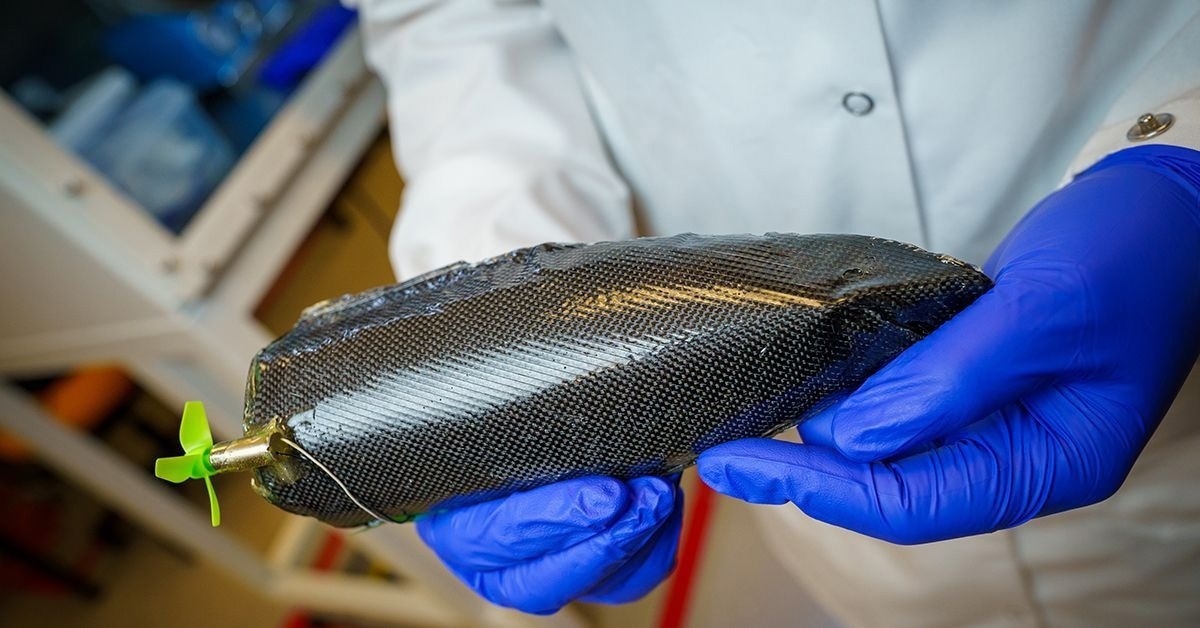Envision a phone case not just for protection but also serving as a reservoir of energy, or an electric car where the doors and floorboard store energy for propulsion. These futuristic concepts may one day become a reality, thanks to the recent advancements made by engineers at the University of California San Diego.

This miniature boat is built from a structural supercapacitor—a material that provides both structural support and energy storage capabilities. Image Credit: David Baillot/UC San Diego Jacobs School of Engineering
These researchers have successfully created a structural supercapacitor, a device that combines structural support with energy storage capabilities. This innovation could potentially enhance the power capacity of electronic devices and vehicles without increasing their weight, resulting in longer-lasting battery life on a single charge.
The concept of structural supercapacitors is not entirely novel, but the longstanding challenge has been to create a single device that excels in both bearing mechanical loads and efficiently storing electrical energy. Traditional supercapacitors are excellent at energy storage but lack the necessary mechanical strength to serve as structural components. Conversely, structural materials can provide support but often fall short in terms of energy storage capacity.
Now, a team led by Tse Nga (Tina) Ng, in collaboration with Xinyu Zhang, both professors of electrical and computer engineering at UC San Diego, has successfully achieved the best of both worlds with a groundbreaking structural supercapacitor. Their research, recently published in Science Advances, showcases a solution that combines mechanical strength with efficient energy storage.
To validate their concept, the researchers employed their structural supercapacitor to construct a miniature solar-powered boat. They shaped the supercapacitor to serve as the boat's hull, then integrated a small motor and circuitry.
This circuit was connected to a solar cell. When exposed to sunlight, the solar cell charged the supercapacitor, which, in turn, provided power to propel the boat's motor. In test runs, the boat effectively navigated across the water, showcasing the practicality of this innovative energy storage solution.
The device's composition includes the typical supercapacitor elements: a pair of electrode surfaces separated by an electrolyte, facilitating the flow of ions between the electrodes. What sets this device apart is the careful selection of materials designed to enhance both mechanical strength and electrochemical performance.
The electrodes in this device are crafted from carbon fibers intricately woven into a fabric. This carbon fiber fabric not only imparts considerable structural strength but also serves as the foundation for the device's overall stability. Additionally, it is coated with a unique blend comprising a conductive polymer and reduced graphene oxide, a combination that significantly bolsters the flow of ions and enhances energy storage capacity.
The solid electrolyte, another pivotal component, is a composite material comprised of epoxy resin and a conductive polymer known as polyethylene oxide. The epoxy resin contributes structural integrity, while the inclusion of polyethylene oxide facilitates ion mobility by creating a network of pores throughout the electrolyte, further improving the device's performance.
A major design element in this innovation is the deliberate variation in the concentration of polyethylene oxide within the electrolyte, leading to the creation of concentration gradients. Regions near the electrodes contain a higher concentration of polyethylene oxide. This setup facilitates faster and more unimpeded ion movement at the interface between the electrode and the electrolyte, ultimately enhancing electrochemical performance.
However, it is worth noting that a higher polyethylene oxide concentration results in more pores within the material, potentially compromising its structural integrity. To strike a delicate balance, the central portion of the electrolyte is engineered with a lower polyethylene oxide concentration. This ensures it maintains structural stability while still facilitating an efficient flow of ions.
This gradient configuration is the trick to achieving optimal performance in the electrolyte. Instead of using a single electrolyte configuration, we structured it so that the edges that contact the electrodes have higher electrical performance while the middle is mechanically stronger.
Tse Nga (Tina) Ng, Professor, Electrical and Computer Engineering, University of California San Diego
While this achievement marks a significant step forward in the realm of structural energy storage, the researchers acknowledge that there is still substantial work ahead. Supercapacitors, in general, are known for their high power density, enabling them to provide substantial bursts of energy rapidly.
However, they typically exhibit lower energy density when compared to conventional batteries. Balancing these characteristics to achieve a superior structural supercapacitor remains a significant challenge.
Our future work will focus on increasing the energy density of our supercapacitor and making it comparable to some battery packs. The ultimate goal would be to achieve both higher energy density and power density.
Lulu Yao, Study First Author and PhD Student, Materials Science and Engineering, University of California San Diego
The co-authors are Kai Zheng, Nandu Koripally, and Xinyu Zhang, UC San Diego; and Naresh Eedugurala and Jason D. Azoulay, University of Southern Mississippi.
The research was made possible through support from the National Science Foundation, including grants PFITT 2120103, MCA 2120701, and CNS-1901048.
Additionally, the work involved the utilization of resources at the San Diego Nanotechnology Infrastructure (SDNI) at UC San Diego, which is a part of the National Nanotechnology Coordinated Infrastructure, and this support was provided by the National Science Foundation under grant ECCS-1542148.
Mini boat built from a supercapacitor
Video Credit: University of California San Diego
Journal Reference
Yao, L., et al. (2023). Structural pseudocapacitors with reinforced interfaces to increase multifunctional efficiency. Science Advances. doi.org/10.1126/sciadv.adh0069.